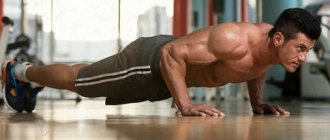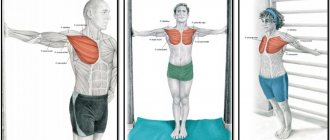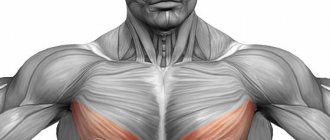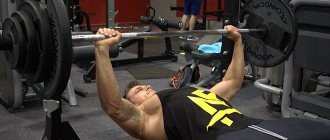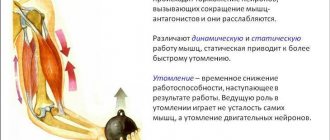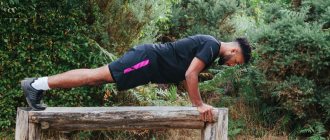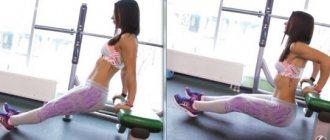- September 7, 2018
- Home workouts
- Nikita Novikov
Wide-grip push-ups are a fairly popular exercise among both professional and amateur athletes. Its popularity can be explained in one word - simplicity. Push-ups from the floor with any position of the hands can be done anywhere; to perform them, you only need the floor and the desire of the athlete himself. But before you add push-ups to your training program, you need to understand the variations of this exercise. In our publication today, we will describe in detail the benefits of wide-grip push-ups and the correct technique, and also find out which muscles will be involved in the work. Interested? Then start reading quickly!
Introduction to the topic
Before you start lifting weights, you need to make sure that your musculoskeletal system is ready for it.
If you have difficulty training with your own weight, then your body is not yet ready to work with weights. Push-ups will help strengthen muscles and joints and increase the energy potential of the body.
If you are already working with iron, then the exercise can be performed as a warm-up, and doing push-ups with weights can be a complete replacement for barbell and dumbbell presses.
Difficulty Level Rating
In the world of bodybuilding, all exercises are divided into levels depending on their complexity. It may look like this: the simplest ones are classified, for example, in the “one star” category. The higher the difficulty, the higher the level assigned. Exercises of increased complexity – “five stars” category.
Wide-grip push-ups are classified as “three stars.” This is considered a medium level of difficulty. That is, this exercise is not so simple, but quite effective. By the way, some “jocks” with many years of experience use it to correct the shape of the pectoral muscles, but they do this only with weights.
What muscles work
The main load is taken by the pectoral muscles and triceps. The front deltoids, abs, back, buttocks and legs also work.
The wider the grip when doing push-ups, the more the chest swings and the less the triceps.
There is even an option for biceps, when the arms are pressed tightly to the body and the fingers point towards the feet. But I will not consider this option due to the risk of injury. Yes, and it applies more to push-ups with a narrow grip.
Increasing loads
During regular push-ups, when your body is horizontal to the floor, you are working with approximately 64% of your body weight. If your weight is 70 kg, then during the exercise 45 kg are included in the work.
If you are a beginner, then this load is more than enough for you. However, if you want to achieve maximum development of the pectoral muscles, then you will have to gradually increase the load.
Any professional athlete, or even just a person who goes to the gym, knows perfectly well that performing a bench press (a basic exercise for the chest) with a weight of 45 kg is not a very difficult task.
Therefore, there are two effective ways to increase the load. One thing has already been mentioned above, you need to use a high support or special handles for push-ups
. Research has shown that if you use these two methods to increase amplitude, the load increases from 64% to 75% of your body weight. When using support, it is advisable to place your hands and feet as wide as possible. In sports parlance, this will allow you to trim your pectoral muscles and be more stable.
The second option is to use weights
. To increase the load, a special weighted vest or any weight on your back will help you. However, as for the load on your back, it is much more difficult here than with a vest, since most likely you will not be able to do this without an assistant. But, if there is no one nearby, take a backpack, put a load in it and fasten it on your back as tightly and high as possible.
However, the first method of increasing the load (using supports) will not be able to give you the proper load for a long time; for this you will have to use the second option of increasing the load; besides, you can also use weights when doing push-ups on parallel bars with a wide grip.
Correct technique and types of exercises
General rules. The distance between the palms is 1.5-2 times the width of the shoulders. The back and legs are on the same line, and the elbows look to the sides. You can do push-ups on your palms, fists and fingers. The last two options increase the distance of the torso from the floor, which allows for a stronger stretch of the muscles in the lower position. They also strengthen the joints and tendons of the hands.
If you find it difficult to perform the exercise with emphasis on your toes, you can do push-ups from your knees, or reduce the width of your palms. Over time, you will be able to perform full wide push-ups.
From the floor
Take a lying position. As you inhale, lower yourself down as low as possible, but do not rest your chest on the support. As you exhale, rise up, trying to contract your pectoral muscles as much as possible.
From the shop
The execution technique is similar to horizontal push-ups, but depending on what is on the bench, the difficulty of the execution increases or decreases.
The option when your hands rest on the bench is easier and well suited for beginners. The load shifts to the lower part of the pectoral muscles.
When your hands are on the floor and your feet are on the bench, the difficulty increases. The load shifts to the upper chest.
Watch these videos. They will help you better understand the intricacies of the exercise.
How to learn to do push-ups for a beginner?
What should you do if, in theory, you know the technique of wide-grip push-ups by heart, but in practice you can’t even do a single push-up on the floor? If you are also in a similar situation, then don’t worry! In this case, push-ups on your knees are suitable for you - the starting stage for many beginners. The technique for performing them differs from the technique for performing regular push-ups only in that they are done with the knees on the floor. This approach makes the exercise several times easier, since a significant part of your weight is simply not used in the work. Over time, when it becomes very easy for you to perform this exercise, you will be able to move on to classic push-ups with wide arms.
When doing wide-grip push-ups, what muscles are working? How to do push-ups with wide arms? How to get pumped up with wide push-ups? We think we were able to provide complete and detailed answers to these questions. We hope that the information provided in the article was interesting to you. We wish you success in your training!
Example workout
Do push-ups on chest training day. Before training, be sure to stretch your shoulders, elbows and hands, making rotational movements.
At home
- Wide push-ups – 3 sets of 12 reps.
- Dumbbell bench press – 3 to 12.
- Push-ups (feet on the bench) – 3 x 12 repetitions.
- Dumbbell flyes – 3 to 12.
In the gym
- Dips - 3 x 12 reps.
- Wide push-ups – 3 to 12.
- Bench press – 3 to 12.
- Reduction of arms on the upper block – 3 x 14 repetitions.
After your workout, cool down. It should include stretching and calming exercises. For example, hang on the bar for 30-40 seconds, and then clasp your fingers behind your back and hold in this position for 45 seconds. This will help the muscles recover faster and reduce pain.
Summarize
Any push-ups bring great benefits to all systems of our body, and they are also the safest exercise for the pectoral muscles.
So if your goal is to strengthen and define your pectoral muscles, triceps and deltoids, then push-ups are the most suitable exercise. But, if you need volume, then without using weights (weights) you will not achieve the desired result.
Exercise, eat right and get better - good luck to you.
Training Tips
Equipment
Clothing should be comfortable and breathable. To protect against injuries and sprains, use bandages or wristbands.
Sets and reps
If you have difficulty performing 15-20 repetitions, then three approaches to the maximum will be enough. If all the repetitions are easy, place a load on the upper back of such a size that you can do 10-12 repetitions in a set when training for mass and 15-20 repetitions when training for relief. The number of approaches is 3-4.
When to make an exercise more difficult
For muscle growth, the number of repetitions should not exceed 12. If you easily perform all the repetitions, then you need to make push-ups more difficult. To do this, use weights, push-up supports, or perform the exercise with your feet on a bench.
Nutrition and sports supplements
Meals should be fractional 5 times a day. To grow muscle mass, eat more protein foods. Additional sources of protein include protein shakes and bars. Eat food immediately after training.
To lose weight, eat low-calorie foods, and your meal should be no earlier than 2 hours after training.
Push-ups put a lot of stress on the joints and ligaments of the hands, so to prevent injuries, it would not be a bad idea to take special complexes: chondroitin, glucosamine, collagen, as well as vitamins and minerals.
How to start training
It is best to train every other day, that is, Monday - Wednesday - Friday or Tuesday - Thursday - Saturday. Although you can train like this: Monday - Tuesday - Thursday - Friday. In general, as you understand, it doesn’t matter what days to train, the main thing is that there are at least 2 days of rest per week, since the development of certain physical qualities does not occur during training, but on rest days.
If you are just starting to master push-ups and the world of physical training in general, then start with a small number of repetitions or with an easier version of push-ups.
However, in order to progress well, you need to eat right, rest well and constantly increase your load. A training diary will help you track your progress, where you will record all the training data, for example, the number of repetitions, sets, weight, and so on. With the help of this diary you will be able to objectively evaluate your results.
Key Points to Understand
: If your goal is to lose weight and add definition to your muscles, then you need to do a lot of light push-ups (repetitions), supplement your workout with cardio (running, cycling, swimming) and eat right to lose weight. And if your goal is to pump up muscle mass and tone it, then you need to: perform fewer repetitions, but at the same time constantly progress (add) the load, get enough rest and eat right for muscle growth.
However, if you don’t see progress in training for too long (about a week or two) then you need to change the training program, that is, review your rest days (how well you rest), nutrition and load level (make it more difficult or easier).
Also, do not forget about warming up, which prepares your body for the upcoming load. After a good warm-up, you can start with heavy versions of push-ups, that is, wide-grip push-ups, and then move on to lighter versions. This is necessary so that you have the strength (energy) for the difficult option, otherwise you will not be able to progress well. For example, according to the plan, you need to do 4 exercises: 2 exercises for the abs and 2 for developing the pectoral muscles. Start by performing several sets of “wide” push-ups, and for the third exercise, choose a lightweight version with a bench or any other object, when your head is higher than your torso.
Benefits and harms
- Push-ups with a wide support allow you to increase the strength of your arms, back and abs;
- This is a great way to challenge your muscles without using extra weight;
- You can do push-ups in this way at home, on the street, and in the gym;
- The exercise helps women improve their breast shape, pump up their arms, and tighten their stomach;
- This is a great way to build muscle definition and improve muscle elasticity.
The exercise cannot cause harm, the exception being situations when a person begins to do push-ups if there are contraindications:
- Injuries to joints, ligaments, tendons;
- Diseases of the musculoskeletal system;
- Exacerbation of chronic diseases;
- Inflammatory processes occurring against the background of elevated body temperature;
- High blood pressure;
- Excessive excess weight;
- Condition after abdominal surgery;
- Special situations incompatible with sports physical activity.
Push-ups with wide arms: the essence of the exercise
Push-ups are a basic exercise that develops an athlete’s physical fitness with a simple but effective movement: raising and lowering the body with the help of hands in a horizontal position facing down. Partially identical in their biomechanics to the bench press, they make it possible to work several muscle groups simultaneously.
Push-ups are traditionally included in the training programs of many armies around the world. Soldiers do this exercise every day as part of a standard system for assessing their level of fitness.
With
Classic push-ups are one of the key elements of upper body training at home.
What muscles are activated in push-ups?
The reverse press has a reputation as a difficult exercise because, in addition to stressing the main working muscles, it forces almost the entire body to work to maintain balance.
The greatest load is received by:
- pectoralis major muscles (if you place your arms wide, their outer areas are more involved);
- deltoids (mostly the anterior bundles);
- serratus anterior muscles, located in the area of the upper ribs in the lateral part of the chest;
- triceps (in training with a wide stance, they are less involved in the work, but take on a certain part of the load).
The abdominal muscles, gluteal muscles and back muscles are actively used as stabilizers. These muscle masses fix the body in the correct position throughout the exercise, so the correct movement technique largely depends on their work.
By doing push-ups, an athlete essentially performs a plank with outstretched arms - a static exercise that strengthens the entire body, and above all, the abdominal muscles. Therefore, by training in this way, you can get an additional bonus: a toned stomach and strong abdominals.
V
Benefits of Exercise
The Reverse Press helps develop muscle and strength in the upper body using only your own body weight. It gives a high metabolic effect, since part of the muscles works dynamically, and the remaining muscles receive a static load, keeping the body in a straight position.
The exercise is functional because it improves capabilities that are indispensable in everyday activities. Thus, the shoulder joint, which is constantly involved in many movements, is very unstable and is more susceptible to injury than other joints. By doing push-ups, the athlete works the small stabilizing muscles of the shoulder, strengthening it.
To do push-ups, you don't need any equipment, just your own hands and a hard surface that can serve as support. The athlete’s body weight acts as the working weight. Therefore, you can train this way anywhere - push-ups are universal and accessible to everyone.
m
The exercise in question strengthens the heart and blood vessels and has a positive effect on the respiratory system.
You can do push-ups in different ways: this training is designed for any level of fitness and a variety of training goals.
What is the difference between wide push-ups and narrow push-ups?
First of all, the exercise differs in the distribution of the load:
- with a narrow setting, the load is placed on the triceps and the middle part of the pectoral muscles;
- and with a wide one - the lateral parts of the pectoral muscles.
Also, this version of push-ups implies a vertical position of the arms, with the elbows pressed as close as possible to the torso, as opposed to a wide stance.
Description
1. Stand on the floor in a push-up position with your hands shoulder-width apart. Provided there is no discomfort in the wrists, you can place your hands with a narrow grip.
2. Lower your body slowly, reducing the distance from your chest to the floor, lift yourself up, including your triceps as much as possible.
This is a multi-joint exercise for the triceps , shoulders and chest. Unilateral push-ups are possible, but only for very light or super strong people.
Helpful hints. What rocks when doing push-ups?
To better engage the outer triceps, rotate your hands slightly toward each other. Another way to adjust the load is to change the angle between the torso and arms. Choose the position in which you feel the triceps most: your hands should be on the floor, at a level somewhere between the shoulder girdle and the pectoral muscles.
The note
The narrower your hand placement, the more you feel the triceps. However, if you engage your pectoral muscles while doing the exercise, it will be much harder to do push-ups using a narrow grip.
Muscles at work
We evaluate the load using a ten-point system. We sum up the total load.
| Triceps | 8 (high) |
| Breast | 6 (average) |
| Press | 3 (weak) |
| Anterior delta | 2 (weak) |
| Quadriceps | 1 (weak) |
| Type of exercise | Power - basic |
| Total load | 19 (average) |
